BCN3D Industrial Grade Filaments are formulated to deliver highest results for BCN3D Printers. The filaments are
Manufactured by BASF & Mitsubishi Chemicals to ensure highest print quality to cover most of the technical Proto / End Use requirements.
BCN3D Industrial Grade Filaments are formulated to deliver highest results for BCN3D Printers. The filaments are
Manufactured by BASF & Mitsubishi Chemicals to ensure highest print quality to cover most of the technical Proto / End Use requirements.
BCN3D Filaments
Available
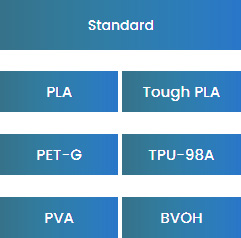
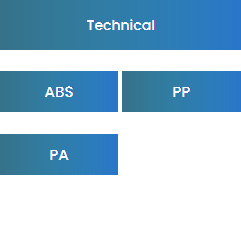

Under Development
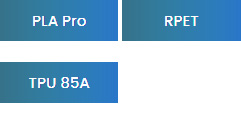
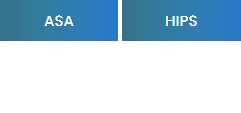
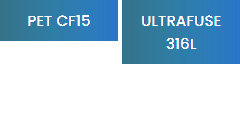
Overview
PLA (Polylactic Acid) is a biodegradable, sustainable and food safe polymer made from organic sources.
It is the most common used filament in FFF 3D printers for its ease of use and wide range of applications, specially those not mechanically or thermally demanding. Definitely a good starting point to learn about the 3D Printing manufacturing process.
Compatibility: Find out the BCN3D printers and filaments compatibility
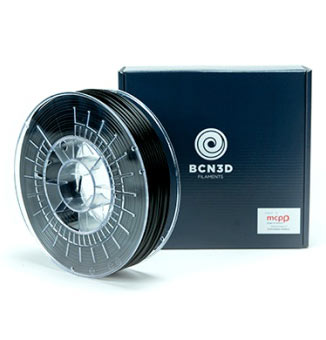
Applications

Properties

Extruder temp.
180º C – 210º C

Cooling fan
100%

Min. layer height
0.08 – 0.2 mm

Bed temp.
65º C Sigma & Sigmax
45º C Epsilon

Speed
40 – 80 mm/s
For BCN3D Cura users:
Get a proper printing profile for PLA using the ones integrated into the BCN3D Cura. Download the latest version of BCN3D Cura.
Bed adhesion:
To ensure good bed adhesion use Magigoo.
Recommendations:
Overview
Tough PLA (Polylactic Acid) is engineered for its high impact resistance and strength, similar to those of ABS, in combination with the stiffness of PLA. This material shows excellent results in layer adhesion and is the perfect match for tooling or manufacturing aids where a high impact is needed. Tough PLA is an easy to print material with a very good surface quality.
Compatibility: Find out the BCN3D printers and filaments compatibility

Applications
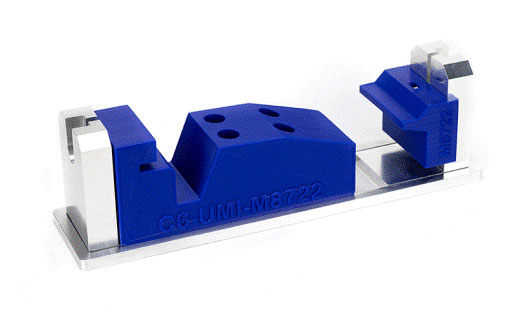
Properties

Extruder temp.
190° C – 220° C

Cooling fan
100%

Min. layer height
0.15 – 0.4mm

Bed temp.
45° C – 60° C

Speed
25 – 60mm/s
For BCN3D Cura users:
Get a proper printing profile for Tough PLA using the ones integrated into the BCN3D Cura. Download the latest version of BCN3D Cura.
Bed adhesion:
To ensure good bed adhesion use Magigoo.
Recommendations:
Overview
PET-G (Polyethylene terephthalate glycol-modified) is a polyester thermoplastic characterised by a good balance of tensile strength and elongation at break. Its high resistance to water and chemicals makes it the material of choice for water-tight containers and protective cases.
PET-G is a versatile technical material, as easy to print as PLA, but with an improved balance of mechanical, chemical and thermal properties.
Compatibility: Find out the BCN3D printers and filaments compatibility

Applications

Properties

Extruder temp.
240º C – 260º C

Cooling fan
0-25%

Min. layer height
0.1 – 0.2 mm

Bed temp.
90º C

Speed
40 – 80 mm/s
For BCN3D Cura users:
Get a proper printing profile for PET-G using the ones integrated into the BCN3D Cura. Download the latest version of BCN3D Cura.
Bed adhesion:
To ensure good bed adhesion use Magigoo.
Recommendations:
Enclosure is recommended for BCN3D Sigma and Sigmax printers.
Overview
TPU (Thermoplastic polyurethane) is an elastomeric copolymer, made up of alternating soft and hard blocks, which give hardness and flexibility at the same time. This material is ideal for those applications where flexibility and durability are highly desired.
With Shore-A hardness of 98, TPU is a resistant material for several industrial applications, both mechanical or chemical. Moreover, it’s been especially designed to improve the 3D printing experience.
Compatibility: Find out the BCN3D printers and filaments compatibility

Applications
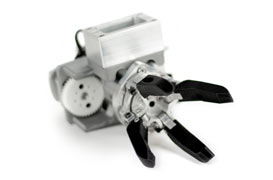
Properties

Extruder temp.
220º C – 260º C

Cooling fan
–

Min. layer height
≥0.1mm

Bed temp.
40º C

Speed
15-40mm/s
For BCN3D Cura users:
Get a proper printing profile for TPU using the ones integrated into the BCN3D Cura. Download the latest version of BCN3D Cura.
Bed adhesion:
To ensure good bed adhesion use Magigoo.
Recommendations:
Overview
PVA (Polyvinyl alcohol) is a water-soluble thermoplastic, widely adopted as a support material for FFF 3D printers. Optimized for the FFF manufacturing process, our PVA is compatible with most of BCN3D filaments and can be easily printed to create the support and then dissolved with ordinary water.
PVA supports allow to achieve better surface quality, to orientate the part to get better mechanical properties and even to print multi-component models and mechanisms.
Compatibility: Find out the BCN3D printers and filaments compatibility
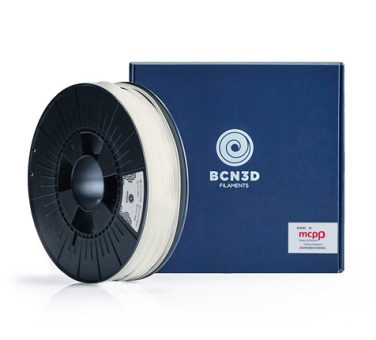
Applications

Properties

Extruder temp.
210º C – 230º C

Cooling fan
50%

Min. layer height
≥0.1mm

Bed temp.
60º C

Speed
–
For BCN3D Cura users:
Get a proper printing profile for PVA using the ones integrated into the BCN3D Cura. Download the latest version of BCN3D Cura.
Bed adhesion:
To ensure good bed adhesion use Magigoo.
Recommendations:
Overview
BVOH (Butenediol vinyl alcohol copolymer) is a water-soluble thermoplastic optimized for the FFF manufacturing process. Our BVOH extends the compatibility with most of BCN3D filaments and can be easily printed to create the support and then dissolved with ordinary water. In comparison with PVA, BVOH supports allow to achieve better surface quality, to orientate the part to get better mechanical properties and even to print multi-component models and mechanisms with a fastest dissolution and easier to remove.
Compatibility: Find out the BCN3D printers and filaments compatibility
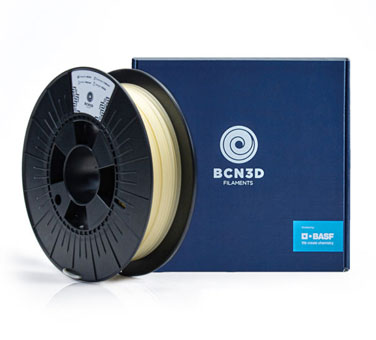
Applications
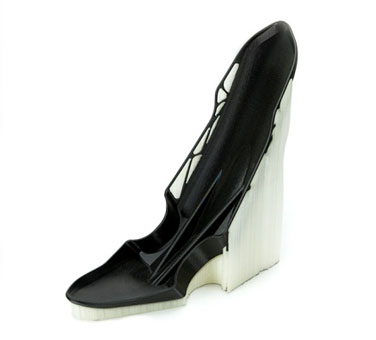
Properties

Extruder temp.
190º C – 210º C

Cooling fan
50% – 100%

Min. layer height
0.15 – 0.4 mm

Bed temp.
45ºC – 90ºC

Speed
20 mm/s
For BCN3D Cura users:
Get a proper printing profile for BVOH using the ones integrated into the BCN3D Cura. Download the latest version of BCN3D Cura.
Bed adhesion:
To ensure good bed adhesion use Magigoo.
Recommendations:
Overview
PLA (Polylactic Acid) is a biodegradable, sustainable and food safe polymer made from organic sources.
It is the most common used filament in FFF 3D printers for its ease of use and wide range of applications, specially those not mechanically or thermally demanding. Definitely a good starting point to learn about the 3D Printing manufacturing process.
Compatibility: Find out the BCN3D printers and filaments compatibility

Applications

Properties

Extruder temp.
180º C – 210º C

Cooling fan
100%

Min. layer height
0.08 – 0.2 mm

Bed temp.
65º C Sigma & Sigmax
45º C Epsilon

Speed
40 – 80 mm/s
For BCN3D Cura users:
Get a proper printing profile for PLA using the ones integrated into the BCN3D Cura. Download the latest version of BCN3D Cura.
Bed adhesion:
To ensure good bed adhesion use Magigoo.
Recommendations:
Overview
Tough PLA (Polylactic Acid) is engineered for its high impact resistance and strength, similar to those of ABS, in combination with the stiffness of PLA. This material shows excellent results in layer adhesion and is the perfect match for tooling or manufacturing aids where a high impact is needed. Tough PLA is an easy to print material with a very good surface quality.
Compatibility: Find out the BCN3D printers and filaments compatibility

Applications

Properties

Extruder temp.
190° C – 220° C

Cooling fan
100%

Min. layer height
0.15 – 0.4mm

Bed temp.
45° C – 60° C

Speed
25 – 60mm/s
For BCN3D Cura users:
Get a proper printing profile for Tough PLA using the ones integrated into the BCN3D Cura. Download the latest version of BCN3D Cura.
Bed adhesion:
To ensure good bed adhesion use Magigoo.
Recommendations:
Overview
PET-G (Polyethylene terephthalate glycol-modified) is a polyester thermoplastic characterised by a good balance of tensile strength and elongation at break. Its high resistance to water and chemicals makes it the material of choice for water-tight containers and protective cases.
PET-G is a versatile technical material, as easy to print as PLA, but with an improved balance of mechanical, chemical and thermal properties.
Compatibility: Find out the BCN3D printers and filaments compatibility

Applications

Properties

Extruder temp.
240º C – 260º C

Cooling fan
0-25%

Min. layer height
0.1 – 0.2 mm

Bed temp.
90º C

Speed
40 – 80 mm/s
For BCN3D Cura users:
Get a proper printing profile for PET-G using the ones integrated into the BCN3D Cura. Download the latest version of BCN3D Cura.
Bed adhesion:
To ensure good bed adhesion use Magigoo.
Recommendations:
Enclosure is recommended for BCN3D Sigma and Sigmax printers.
Overview
TPU (Thermoplastic polyurethane) is an elastomeric copolymer, made up of alternating soft and hard blocks, which give hardness and flexibility at the same time. This material is ideal for those applications where flexibility and durability are highly desired.
With Shore-A hardness of 98, TPU is a resistant material for several industrial applications, both mechanical or chemical. Moreover, it’s been especially designed to improve the 3D printing experience.
Compatibility: Find out the BCN3D printers and filaments compatibility

Applications

Properties

Extruder temp.
220º C – 260º C

Cooling fan
–

Min. layer height
≥0.1mm

Bed temp.
40º C

Speed
15-40mm/s
For BCN3D Cura users:
Get a proper printing profile for TPU using the ones integrated into the BCN3D Cura. Download the latest version of BCN3D Cura.
Bed adhesion:
To ensure good bed adhesion use Magigoo.
Recommendations:
Overview
PVA (Polyvinyl alcohol) is a water-soluble thermoplastic, widely adopted as a support material for FFF 3D printers. Optimized for the FFF manufacturing process, our PVA is compatible with most of BCN3D filaments and can be easily printed to create the support and then dissolved with ordinary water.
PVA supports allow to achieve better surface quality, to orientate the part to get better mechanical properties and even to print multi-component models and mechanisms.
Compatibility: Find out the BCN3D printers and filaments compatibility

Applications

Properties

Extruder temp.
210º C – 230º C

Cooling fan
50%

Min. layer height
≥0.1mm

Bed temp.
60º C

Speed
–
For BCN3D Cura users:
Get a proper printing profile for PVA using the ones integrated into the BCN3D Cura. Download the latest version of BCN3D Cura.
Bed adhesion:
To ensure good bed adhesion use Magigoo.
Recommendations:
Overview
BVOH (Butenediol vinyl alcohol copolymer) is a water-soluble thermoplastic optimized for the FFF manufacturing process. Our BVOH extends the compatibility with most of BCN3D filaments and can be easily printed to create the support and then dissolved with ordinary water. In comparison with PVA, BVOH supports allow to achieve better surface quality, to orientate the part to get better mechanical properties and even to print multi-component models and mechanisms with a fastest dissolution and easier to remove.
Compatibility: Find out the BCN3D printers and filaments compatibility

Applications

Properties

Extruder temp.
190º C – 210º C

Cooling fan
50% – 100%

Min. layer height
0.15 – 0.4 mm

Bed temp.
45ºC – 90ºC

Speed
20 mm/s
For BCN3D Cura users:
Get a proper printing profile for BVOH using the ones integrated into the BCN3D Cura. Download the latest version of BCN3D Cura.
Bed adhesion:
To ensure good bed adhesion use Magigoo.
Recommendations:
Overview
ABS (acrylonitrile butadiene styrene) is one of the most common technical materials in several industries around the globe. Its an engineering material which combines rigidity and resistance to impacts. It is the ideal material for technical applications and moving parts.
Traditionally a challenging material to print with FFF printers, it has been re-formulated to ensure good interlayer adhesion and to reduce warping. Our grade allows for excellent dimensional accuracy and high durability.
Compatibility: Find out the BCN3D printers and filaments compatibility

Applications
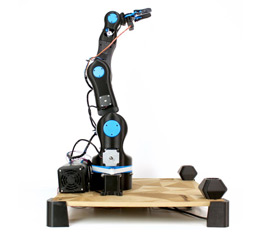
Properties

Extruder temp.
240º C – 260º C

Cooling fan
0-25%

Min. layer height
0.1 – 0.2 mm

Bed temp.
90º C

Speed
40 – 80 mm/s
For BCN3D Cura users:
Get a proper printing profile for ABS using the ones integrated into the BCN3D Cura. Download the latest version of BCN3D Cura.
Bed adhesion:
To ensure good bed adhesion use Magigoo.
Recommendations:
Overview
PP (Polypropylene) is a semycrystalline thermoplastic, known for its resistance to chemical agents. It is completely inert and does not easily interact with any substance, for this reason it is commonly used for the packaging of food and chemicals.
It is a flexible and durable material, with a high resistance to impacts and wear.
Compatibility: Find out the BCN3D printers and filaments compatibility

Applications
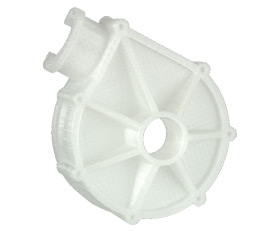
Properties

Extruder temp.
220º C – 240º C

Cooling fan
100%

Min. layer height
0.1 – 0.2 mm

Bed temp.
70º C

Speed
40 – 80 mm/s
For BCN3D Cura users:
Get a proper printing profile for PP using the ones integrated into the BCN3D Cura. Download the latest version of BCN3D Cura.
Bed adhesion:
To ensure good bed adhesion use Magigoo.
Recommendations:
Overview
PA (Polyamide) is an engineering plastic, characterised by its great resistance to impact and able to work continuously at a temperature of up to 120 ºC for an extended period of time.
Its semi-flexible behaviour derives from a semicrystalline structure, which impart strength and durability, best suited for the most demanding technical applications. A low coefficient of friction allows for a short-term use in contact with moving parts.
Compatibility: Find out the BCN3D printers and filaments compatibility

Applications

Properties

Extruder temp.
220º C – 250º C

Cooling fan
–

Min. layer height
≥0.1mm

Bed temp.
95º C

Speed
30-60mm/s
For BCN3D Cura users:
Get a proper printing profile for PA using the ones integrated into the BCN3D Cura. Download the latest version of BCN3D Cura.
Bed adhesion:
To ensure good bed adhesion use Magigoo.
Recommendations:
Overview
ABS (acrylonitrile butadiene styrene) is one of the most common technical materials in several industries around the globe. Its an engineering material which combines rigidity and resistance to impacts. It is the ideal material for technical applications and moving parts.
Traditionally a challenging material to print with FFF printers, it has been re-formulated to ensure good interlayer adhesion and to reduce warping. Our grade allows for excellent dimensional accuracy and high durability.
Compatibility: Find out the BCN3D printers and filaments compatibility

Applications

Properties

Extruder temp.
240º C – 260º C

Cooling fan
0-25%

Min. layer height
0.1 – 0.2 mm

Bed temp.
90º C

Speed
40 – 80 mm/s
For BCN3D Cura users:
Get a proper printing profile for ABS using the ones integrated into the BCN3D Cura. Download the latest version of BCN3D Cura.
Bed adhesion:
To ensure good bed adhesion use Magigoo.
Recommendations:
Overview
PP (Polypropylene) is a semycrystalline thermoplastic, known for its resistance to chemical agents. It is completely inert and does not easily interact with any substance, for this reason it is commonly used for the packaging of food and chemicals.
It is a flexible and durable material, with a high resistance to impacts and wear.
Compatibility: Find out the BCN3D printers and filaments compatibility

Applications

Properties

Extruder temp.
220º C – 240º C

Cooling fan
100%

Min. layer height
0.1 – 0.2 mm

Bed temp.
70º C

Speed
40 – 80 mm/s
For BCN3D Cura users:
Get a proper printing profile for PP using the ones integrated into the BCN3D Cura. Download the latest version of BCN3D Cura.
Bed adhesion:
To ensure good bed adhesion use Magigoo.
Recommendations:
Overview
PA (Polyamide) is an engineering plastic, characterised by its great resistance to impact and able to work continuously at a temperature of up to 120 ºC for an extended period of time.
Its semi-flexible behaviour derives from a semicrystalline structure, which impart strength and durability, best suited for the most demanding technical applications. A low coefficient of friction allows for a short-term use in contact with moving parts.
Compatibility: Find out the BCN3D printers and filaments compatibility

Applications

Properties

Extruder temp.
220º C – 250º C

Cooling fan
–

Min. layer height
≥0.1mm

Bed temp.
95º C

Speed
30-60mm/s
For BCN3D Cura users:
Get a proper printing profile for PA using the ones integrated into the BCN3D Cura. Download the latest version of BCN3D Cura.
Bed adhesion:
To ensure good bed adhesion use Magigoo.
Recommendations:
Overview
PP GF30 (Polypropylene 30% glass fibre) is a composite filament, filled with glass fibre for chemically resistant, lightweight and dimensionally stable parts. It is amongst the most used filled materials in the automotive industry, characterised by a long service life and able to resist to all weather conditions.
Compatibility: Find out the BCN3D printers and filaments compatibility
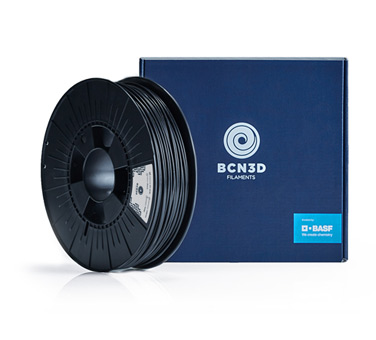
Applications
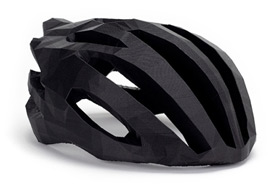
Properties

Extruder temp.
230º C – 250º C

Cooling fan
50%

Min. layer height
0.2 – 0.4 mm

Bed temp.
80º C

Speed
30 – 80 mm/s
For BCN3D Cura users:
Get a proper printing profile for PP GF30 using the ones integrated into the BCN3D Cura. Download the latest version of BCN3D Cura.
Bed adhesion:
To ensure good bed adhesion use Magigoo.
Recommendations:
Only compatible with BCN3D Epsilon when paired with the Hotend X.
Overview
PAHT CF15 (High Temperature Polyamide carbon fiber reinforced) combines high temperature and chemical resistance with extreme mechanical properties.
It allows to work under 150ºC continuous temperatures with the peak temperature of 180ºC in comparison to a standard PA. 15% carbon fiber reinforcement makes it stiffer thus open new fields for the printing of demanding applications.
Compatibility: Find out the BCN3D printers and filaments compatibility
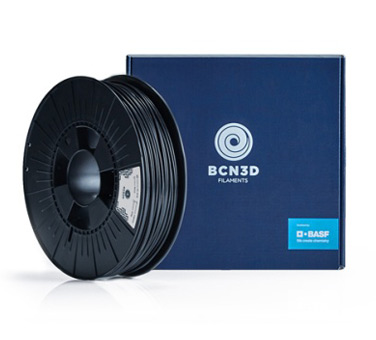
Applications

Properties

Extruder temp.
260º C – 280º C

Cooling fan
0%

Min. layer height
0.2 – 0.4 mm

Bed temp.
95º C

Speed
40 – 60 mm/s
For BCN3D Cura users:
Get a proper printing profile for PP using the ones integrated into the BCN3D Cura. Download the latest version of BCN3D Cura.
Bed adhesion:
To ensure good bed adhesion use Magigoo.
Recommendations:
Overview
PP GF30 (Polypropylene 30% glass fibre) is a composite filament, filled with glass fibre for chemically resistant, lightweight and dimensionally stable parts. It is amongst the most used filled materials in the automotive industry, characterised by a long service life and able to resist to all weather conditions.
Compatibility: Find out the BCN3D printers and filaments compatibility

Applications

Properties

Extruder temp.
230º C – 250º C

Cooling fan
50%

Min. layer height
0.2 – 0.4 mm

Bed temp.
80º C

Speed
30 – 80 mm/s
For BCN3D Cura users:
Get a proper printing profile for PP GF30 using the ones integrated into the BCN3D Cura. Download the latest version of BCN3D Cura.
Bed adhesion:
To ensure good bed adhesion use Magigoo.
Recommendations:
Only compatible with BCN3D Epsilon when paired with the Hotend X.
Overview
PAHT CF15 (High Temperature Polyamide carbon fiber reinforced) combines high temperature and chemical resistance with extreme mechanical properties.
It allows to work under 150ºC continuous temperatures with the peak temperature of 180ºC in comparison to a standard PA. 15% carbon fiber reinforcement makes it stiffer thus open new fields for the printing of demanding applications.
Compatibility: Find out the BCN3D printers and filaments compatibility

Applications

Properties

Extruder temp.
260º C – 280º C

Cooling fan
0%

Min. layer height
0.2 – 0.4 mm

Bed temp.
95º C

Speed
40 – 60 mm/s
For BCN3D Cura users:
Get a proper printing profile for PP using the ones integrated into the BCN3D Cura. Download the latest version of BCN3D Cura.
Bed adhesion:
To ensure good bed adhesion use Magigoo.
Recommendations: